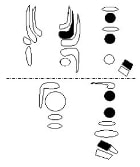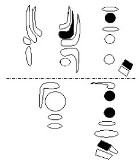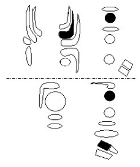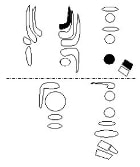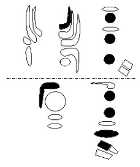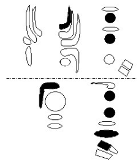2reed.net
Ministry to Double Reed Musicians
Stravinsky, Igor. Rite of Spring
Entries arranged by opening solo first, then second solo

Stravinsky, Igor. Rite of Spring. Corey, Gerald (25 May 1995).
D5:
Eb
x o x | o o x Ab
d F#
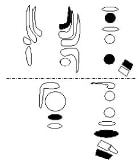
Stravinsky, Igor. Rite of Spring (opening?). de Gomar, Juan. In Apfelstadt, Marc and Klimko, Ronald. Bassoon Performance Practice, Teaching Materials, Techniques and Methods. Idaho: University of Idaho, 1993, p. 55. Recommends fingerings for B4 and C5 found in Cooper pp. 305 and 320.
B4: C5:
Eb Eb
x x o | x x o F x o o | x x o F
c c
|
B4:
|
C5:
|
Stravinsky, Igor. Rite of Spring, mm. 1-15. Moritz, Frederick. "A Dissertation on the Use of Alternate Fingerings for Some of the High Register Notes on the Heckel and Heckel- Type Bassoons." The Double Reed 8/3 (Winter 1985): 28-33. The notes are numbered in the music below. The reader is strongly encouraged to refer to the article, since the fingerings below recur throughout the solos.

In measure 1 start C5 with Cooper p. 322 (no D speaker key):
C5. Note #1:
Eb
x o o | o o o
c
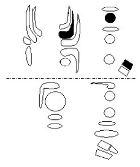
For grace-notes B4 and C5, and sixteenth note B4:
B4. Note #2: C5. Note #3:
x x o | x o o F x o o | x o o F
c c
|
B4:
|
C5:
|
Alternate B4 fingering for the same passage and other B4-C5 grace notes in the passage (see pp. 31 and 33 of the article). No C5 fingering given.
B4. Note #2:
Eb
x x o | x x
c
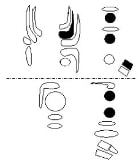
G4 sixteenth (second beat of measure 1):
G4. Note # 5:
Eb
o / x | x o o F


E4 sixteenth (second beat of m. 1):
E4. Note #6:
Eb
x o x | o o x
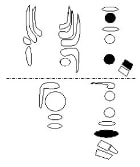
B4 sixteenth (second beat of m. 1):
B4. Note #7:
Eb
x x o | x o o F
a c#
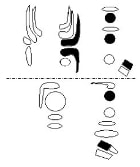

A4 with the fermata (third beat of m. 1):
A4. Note #8:
Eb
x x x | o o x
a c#
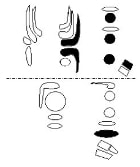
A4 in measure 2, second beat:
A4. Note #9:
Eb
/ x x | o o x Ab
c
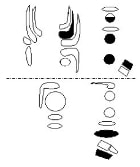

D5 in measure 2. Same as Cooper p. 338:
D5. Note #10:
Eb
o o x | o o x Ab
d
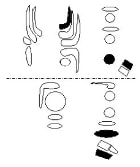
Grace-note G4 in measure 2. Optional half- hole of the L. H. D hole:
G4. Note #11:
Eb
o x x | x o o
Bb
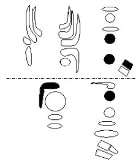
A4, last eighth of measure 2. Same as Cooper p. 275:
A4. Note #12:
Eb
x x x | x o x
a c# Bb
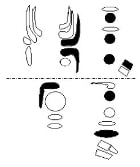

Bb4 in measure 4 (at rehearsal number 1):
Bb4. Note #13:
Eb
x x x | x x o
c E
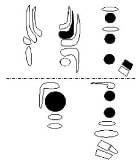
Gb4 in measure 5 (3/4 bar). Same as Cooper p. 230:
Gb4. Note #14:
Eb
o x x | x x o
Bb
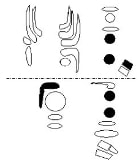


F#4 in measure 15 (3 after rehearsal number 3):
F#4. Note #15:
Eb
/ x x | x x o F
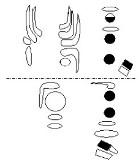
Grace-note A4 in m. 15 (3 after rehearsal number 3). Same as Cooper p. 288:
A4. Note #16:
Eb
x x x | o o o F
a c#
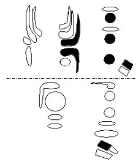
D#4 in m. 15:
D#4. Note #17:
Eb
o x x | o o o
c#
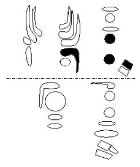
Stravinsky, Igor. Rite of Spring, opening C5. Grossman,
Arthur. email message, 2022 Feb. 20. "I figured something out long
after I had any use for it, but I thought I
would share it with you. For me, one of the real problems in the
opening solo in "Rite" is to get a smooth slur from the high D down to
the G grace note. Try playing the high D with ONLY the third
finger of
the left hand and the low E-flat key, with the normal high D key. The slur comes out smooth as butter.
D5
Stravinsky, Igor. Rite of Spring, opening C5. Porwit, Timothy. In Apfelstadt, Marc and Klimko, Ronald. Bassoon Performance Practice, Teaching Materials, Techniques and Methods. Idaho: University of Idaho, 1993, p. 60. Start with fingering for C#5 then switch to C5 when reed vibrates.

Stravinsky, Igor. Rite of Spring, second solo at rehearsal number 12, m. 25, and following. Ewell, Terry B. (20 August 1994). For Bb4-Cb5 grace-notes use Cooper p. 291 or 292 and open L. H. C hole for Cb5. For downward slur to Gb4 use Cooper p. 226.
Bb4: Cb5:
Eb Eb
x x x |(x) x o F x x o | (x) x o F
a c# a c#
|
Bb4:
|
Cb5:
|
Stravinsky, Igor. Rite of Spring, second solo, m. 25, Cb5-Bb4 grace-notes. Houser, Roy. In Klimko, Ronald. Bassoon Performance Practices and Teaching in the United States and Canada. Idaho: University of Idaho, 1974, p. 64.
Bb4: Cb5:
x x x | x x x F x x o | x x o F
d Bb d Bb
|
Bb4:
|
Cb5:
|
Stravinsky, Igor. Rite of Spring,mm. 25-28. Moritz, Frederick. "A Dissertation on the Use of Alternate Fingerings for Some of the High Register Notes on the Heckel and Heckel-Type Bassoons." The Double Reed 8/3 (Winter 1985): 28-33. The notes are numbered in the music below. The reader is strongly encouraged to refer to the article, since the fingerings below recur throughout the solos.

Cb5 quarter-note and grace-note in measure 25, at rehearsal number 12 (second solo):
Cb5. Note #1:
x x o | x o o F
c
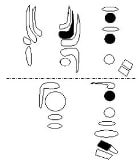
Bb4 grace note and sixteenth note in m. 25:
Bb4. Note #2:
x x x | x x o F
c E

Gb4 in m. 25. Same as Cooper p. 236 except half-hole L. H. D hole:
Gb4. Note #3:
Eb
o / x | x o o

Eb4 in m. 25. Same as Cooper p. 191 except add L. H. Eb key:
Eb4. Note #4:
Eb
x x o | x x x

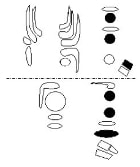
Last Bb4 in measure 25:
Bb4. Note #5:
Eb
x x x | x x o
E
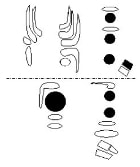
Ab4 in m. 26 without G# ring. Same as Cooper p. 259 except L. H. no whisper key:
Ab4. Note #6:
Eb
/ x x | o o x
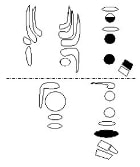
Ab4, with G# ring:
Ab4. Note #6:
Eb
o x x | o o o F


Db5 in m. 26. Same as Cooper p. 331 except L. H. use only D key; R. H. may add the thumb E key.
Db5. Note #7:
Eb
x o x | x o x
d (E)
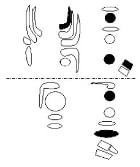
Grace-note Gb4 in m. 26. Same as Cooper p. 230 except half-hole L. H. E hole:
Gb4. Note #8:
Eb
/ x x | x x o
Bb


Last Ab4 in m. 26. Same as Cooper p. 262 except no whisper key:
Ab4. Note #9:
Eb
/ x x | x o x
Bb

Artwork and Graphics by Terry B. Ewell
Copyright 2015-22 by Terry B. Ewell.
